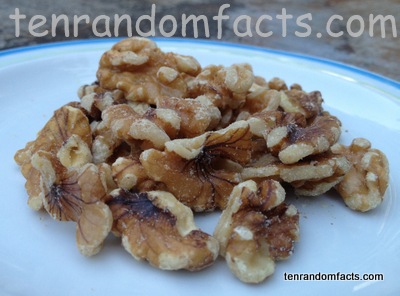Abstract shaped walnuts.
- Walnuts grow on trees with the scientific name ‘Juglans’, of which there are over 20 species, and they belong to the family Juglandaceae, the family of walnuts.
- Walnut trees are deciduous and grow from 10-40 metres (32-131ft) in height, and can live for a few hundred years, bearing fruit (a green husk) which is not edible but do contain edible seeds, known as walnuts, which are encased in a hard shell.
- Walnuts are generally dried for two weeks before they are stored or sold, and can easily become mouldy or insect infected if not suitably stored, and if this occurs, the whole batch of nuts must be discarded.
- Walnut kernels have a bumpy texture, an abstract shape, and are typically a creamy brown colour.
- Commercial walnuts are usually from Juglans regia trees, known as the ‘English’ or ‘Persian walnut’, and are popular because they have a large kernel and a thin shell, and the ‘black walnut’ is also available commercially, but not as common.
- China and USA are the two biggest producers of walnuts, with almost all of the nuts in America, grown in California.
- Walnuts are a good source of protein, folate and copper; a very good source of omega 3, manganese, magnesium, and phosphorous; contain the highest amount of antioxidants out of all the nuts, and have many beneficial health effects.
- The US Air Force used to use ground walnut shells to clean parts of their aircraft until a Chinook helicopter crashed, causing deaths, due to the nut’s grit clogging up the machinery.
- Walnuts can be eaten raw or with salad dishes, vegetable and fruit meals or snacks and desserts or used in baking, and sometimes the oil is extracted and used for various purposes.
- Depending on the species, walnuts are native to various countries around the world, including Iran, North America and Japan.
Bibliography:
Walnut, 2013, Wikipedia, <http://en.wikipedia.org/wiki/Walnut>
Walnuts, 2013, The World’s Healthiest Foods, <http://www.whfoods.com/genpage.php?tname=foodspice&dbid=99>






